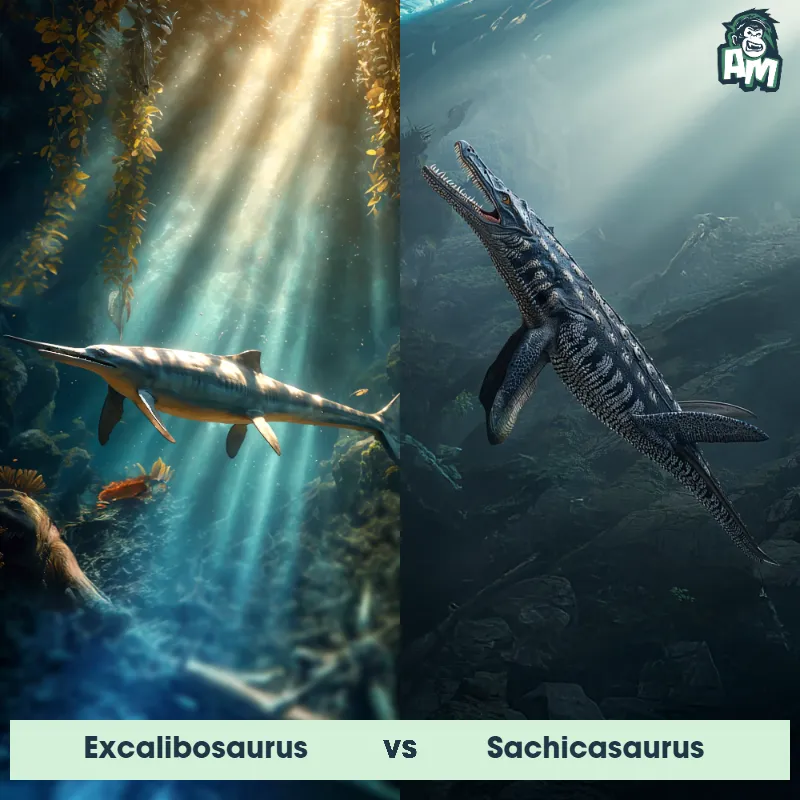The Excalibosaurus
The Excalibosaurus, a prehistoric marine reptile that lived during the Early Jurassic period, was known for its unique sword-like projection on its upper jaw, resembling the legendary sword of King Arthur. This small ichthyosaur had a long, sleek body, streamlined for efficient swimming, and sharp teeth for catching fish and squid.

| Excalibosaurus | |
|---|---|
| Size | 6 feet (1.8 meters) |
| Weight | Unknown |
| Speed | 25mph (40km/h) |
| Key Strength | Speed and agility |
| Biggest Weakness | Small size and lack of physical weaponry |
| Scientific Name | Excalibosaurus |
| Family | Ichthyosaur |
| Habitat | Marine |
| Geography | Worldwide |
| Diet | Small fish and marine creatures |
| Lifespan | 15 years - 20 years |

The Excalibosaurus
The Excalibosaurus, a prehistoric marine reptile that lived during the Early Jurassic period, was known for its unique sword-like projection on its upper jaw, resembling the legendary sword of King Arthur. This small ichthyosaur had a long, sleek body, streamlined for efficient swimming, and sharp teeth for catching fish and squid.
Fun Fact: Excalibosaurus was believed to have relied on its sword-like projection for hunting, using it as a tool to slash through schools of fish and catch its prey.
| Excalibosaurus | |
|---|---|
| Size | 6 feet (1.8 meters) |
| Weight | Unknown |
| Speed | 25mph (40km/h) |
| Key Strength | Speed and agility |
| Biggest Weakness | Small size and lack of physical weaponry |
| Scientific Name | Excalibosaurus |
| Family | Ichthyosaur |
| Habitat | Marine |
| Geography | Worldwide |
| Diet | Small fish and marine creatures |
| Lifespan | 15 years - 20 years |
Excalibosaurus Matchups
We use AI to simulate matchups between the Excalibosaurus and other animals. Our simulation considers size, strength, and natural predatory behaviors to determine the most likely outcome.

Can't find the Matchup you want?
Create Your Own MatchupExcalibosaurus: Diet, Predators, Aggression, and Defensive Behaviors
What did Excalibosaurus eat?
Excalibosaurus were believed to have been carnivorous, preying on small fish and marine invertebrates. Their sharp teeth and streamlined bodies suggested that they were efficient hunters in the ocean.
Did Excalibosaurus have any predators?
As top predators themselves, Excalibosaurus likely had few natural predators. However, larger marine reptiles such as ichthyosaurs or pliosaurs may have posed a threat to them.
Were Excalibosaurus aggressive?
Excalibosaurus were thought to have been aggressive hunters, using their sharp teeth and swift swimming abilities to catch prey. They likely exhibited predatory behavior when hunting for food.
Did Excalibosaurus fight?
Excalibosaurus were solitary hunters and may have engaged in territorial disputes or competition over food sources. While not much is known about their social behavior, it is possible that they may have fought with each other in certain situations.
How did Excalibosaurus defend themselves?
Excalibosaurus likely relied on their speed and agility to evade potential threats. Their streamlined bodies and powerful tail muscles would have allowed them to swiftly maneuver through the water, helping them escape from larger predators.
What was Excalibosaurus' biggest weakness in a fight?
Despite their speed and agility, Excalibosaurus may have been vulnerable to larger, more powerful predators. Their relatively small size compared to some other marine reptiles would have made them easier targets in confrontations. Additionally, if cornered or outnumbered, Excalibosaurus may have struggled to defend themselves effectively.
Fun Fact: Unlike other ichthyosaurs, Excalibosaurus had a striking, sword-shaped snout that set it apart from its relatives and gave it a nickname inspired by the legendary sword Excalibur.
Fun Fact: Excalibosaurus is a relatively rare fossil find, with only a few well-preserved specimens discovered in Europe, making it a fascinating and enigmatic creature in the study of prehistoric marine life.











